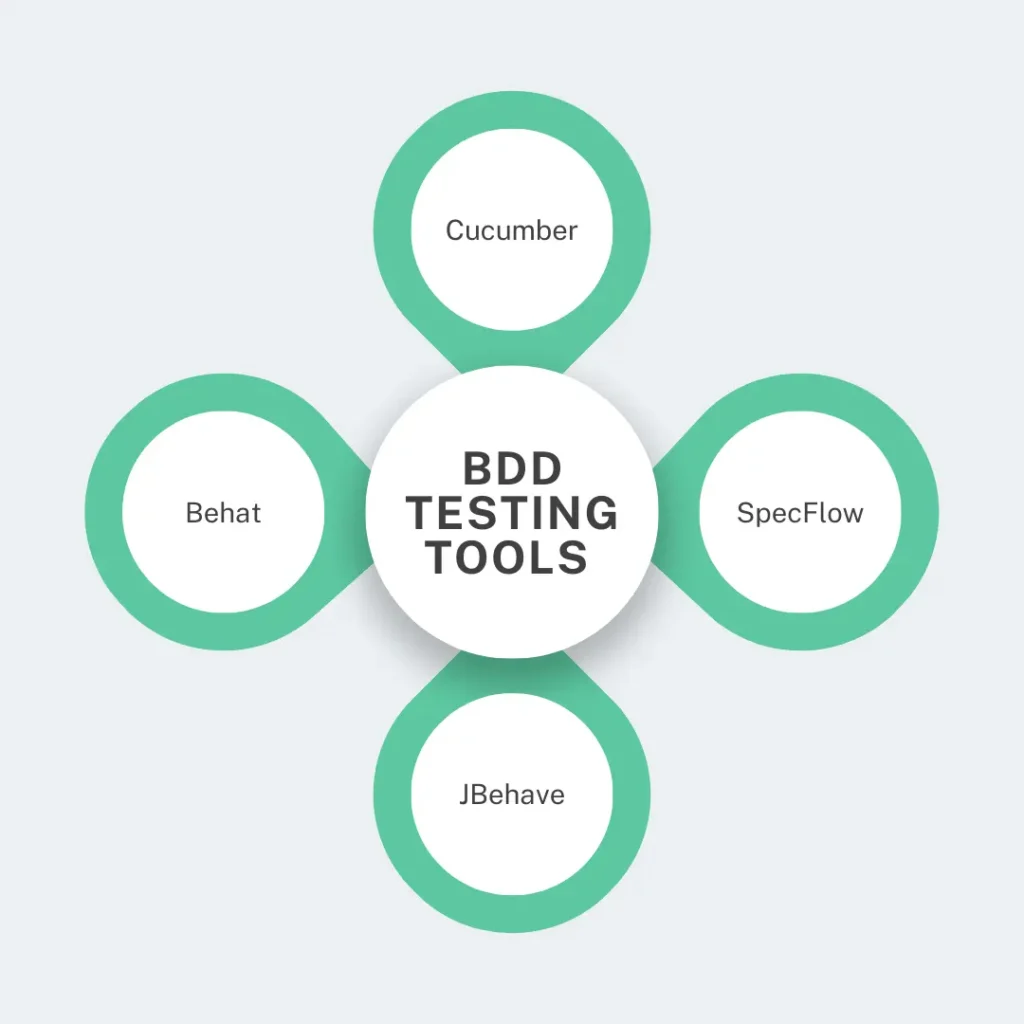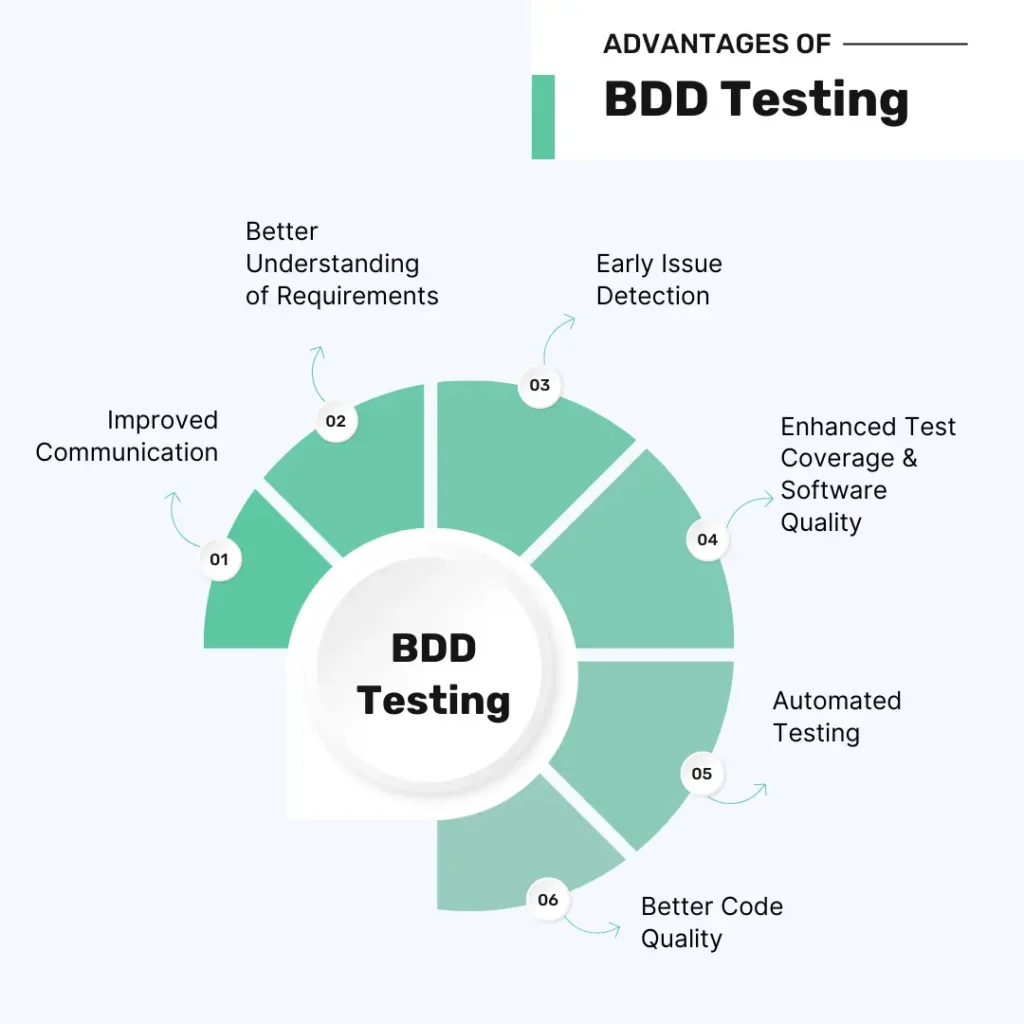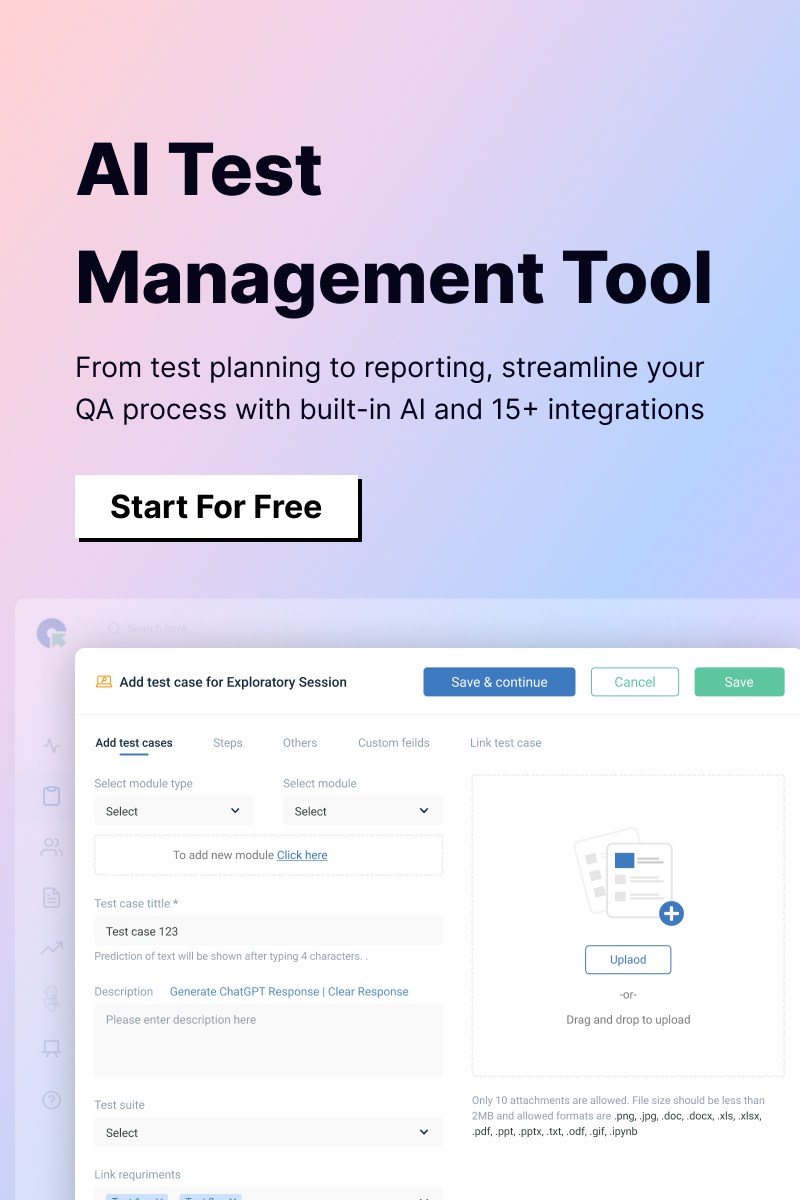For many ordinary users, understanding software can feel overwhelming and intimidating. The technical jargon, complex code, and intricate systems often create a barrier between developers and non-technical stakeholders, such as businesses or clients. This communication gap can lead to confusion, misunderstandings, and delays in software development.
This is where BDD (Behavior-Driven Development) steps in to bridge the gap. BDD testing framework simplifies the process by making test cases simple for anyone to understand, even those without a technical background. By using plain, everyday language to describe how the system should behave, BDD allows everyone—from developers to non-technical team members—to follow along, collaborate, and ensure the software meets the right expectations.
By encouraging collaboration across business and technical teams, BDD testing frameworks help to build a clear and shared understanding of the problem to be solved. It reduces confusion by using simple language and ensures that developers build what the business really needs. With a strong focus on the user experience, the BDD approach ensures that the software behaves exactly how users expect it to.
Traditional testing methods often face various challenges but BDD frameworks adeptly address these issues.
- Communication Gaps: Technical teams and non-technical people may not fully understand each other, leading to misunderstandings.
• BDD testing tools use clear, simple language to describe how the software should behave, ensuring everyone is on the same page. - Unclear Requirements: Developers might build features that don’t match what the business needs due to unclear or missing details.
• BDD tools make sure that requirements are clear from the start, reducing late surprises. - Late Discovery of Issues: Problems are often found late in the process, making them harder and more expensive to fix.
• The BDD process involves developers, testers, and project managers early, allowing them to actively contribute to defining what’s important from the beginning.
In this blog, you’ll learn more about how BDD testing frameworks work, their benefits, and how they can help improve software testing by focusing on clear communication and collaboration.
What is BDD Testing?
BDD testing, or Behavior-Driven Development testing, is a software approach guided by the behavior of an application based on user needs. It brings together key stakeholders, often referred to as the ‘Three Amigos’, — the Businessmen, Developers, and QA testers — to work closely together. The goal is to improve communication by using simple language to describe how the software should behave.
Writing tests in plain English allows all stakeholders to easily understand and agree on the expected behavior of the software. This ensures that the ‘right product’ is being developed, meeting business and user needs. BDD testing frameworks give clear guidance on how to communicate, and this way, everyone involved understands the requirements clearly so that the team can build exactly what the business needs.
Origin of BDD Testing Frameworks
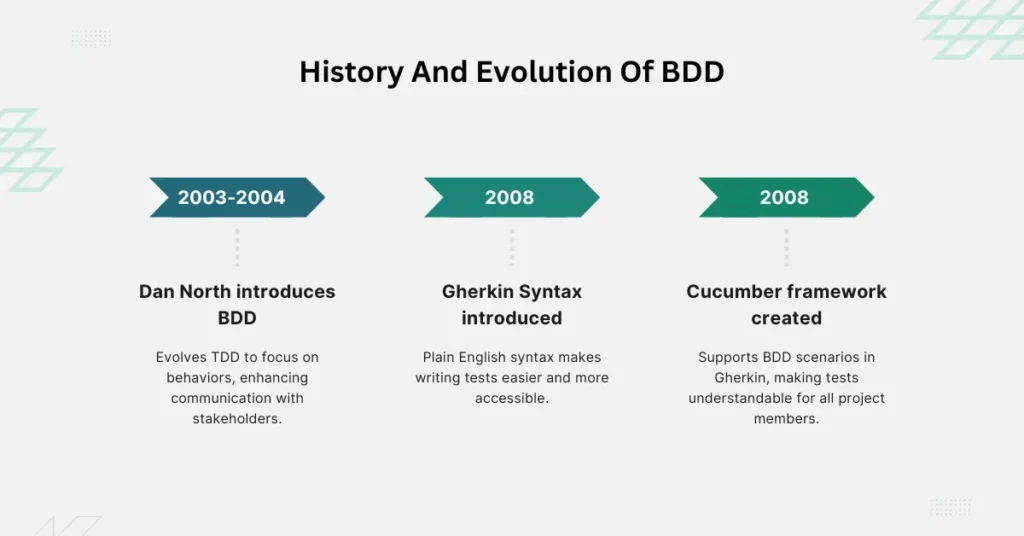
The development of the Behavior-Driven Development (BDD) testing framework can be traced back to key figures and milestones:
- Dan North (2003-’04): Dan North, a software developer, is credited with creating BDD. He introduced BDD as an evolution of Test-Driven Development (TDD) to make it more accessible and improve communication between developers and non-technical stakeholders. He aimed to simplify testing by focusing on behaviors rather than technical details.
- Introduction of Gherkin Syntax (2008): The introduction of Gherkin syntax was a significant milestone in BDD testing frameworks. Gherkin is a plain English language used to write tests in a clear and structured way. It made it easier for non-technical stakeholders to understand and participate in defining the software’s behavior.
- Cucumber (2008): Cucumber, a popular BDD framework tool created by Aslak Hellesøy, is a variant of TDD (Test-Driven Development). It supports writing BDD scenarios in Gherkin, allowing tests to be easily understood by everyone involved in the project.
These key figures and milestones helped shape the BDD testing process into the widely adopted approach for improving collaboration and communication in software development today.
What are the Benefits of BDD Testing Frameworks?
BDD testing frameworks solve common problems in traditional testing, such as miscommunication and confusion about requirements. Developers, testers, and non-technical stakeholders may not always understand each other. Technical jargon and unclear requirements can lead to confusion, causing features to be built incorrectly.
Without clear communication, developers might build something that doesn’t match what the business needs. This can lead to wasted time, resources, and the need for costly revisions later in the process. BDD testing frameworks address these issues by building collaboration and clear communication among project managers, developers, and test engineers.
With BDD testing, everyone works together to define how the software should behave using simple, plain language. This approach ensures the software is built according to the actual needs of the business and its users, reducing the risk of errors and misunderstandings. BDD testing framework promotes a shared understanding of goals, making development more efficient and aligned with business expectations.
How Does BDD Testing Framework Work?
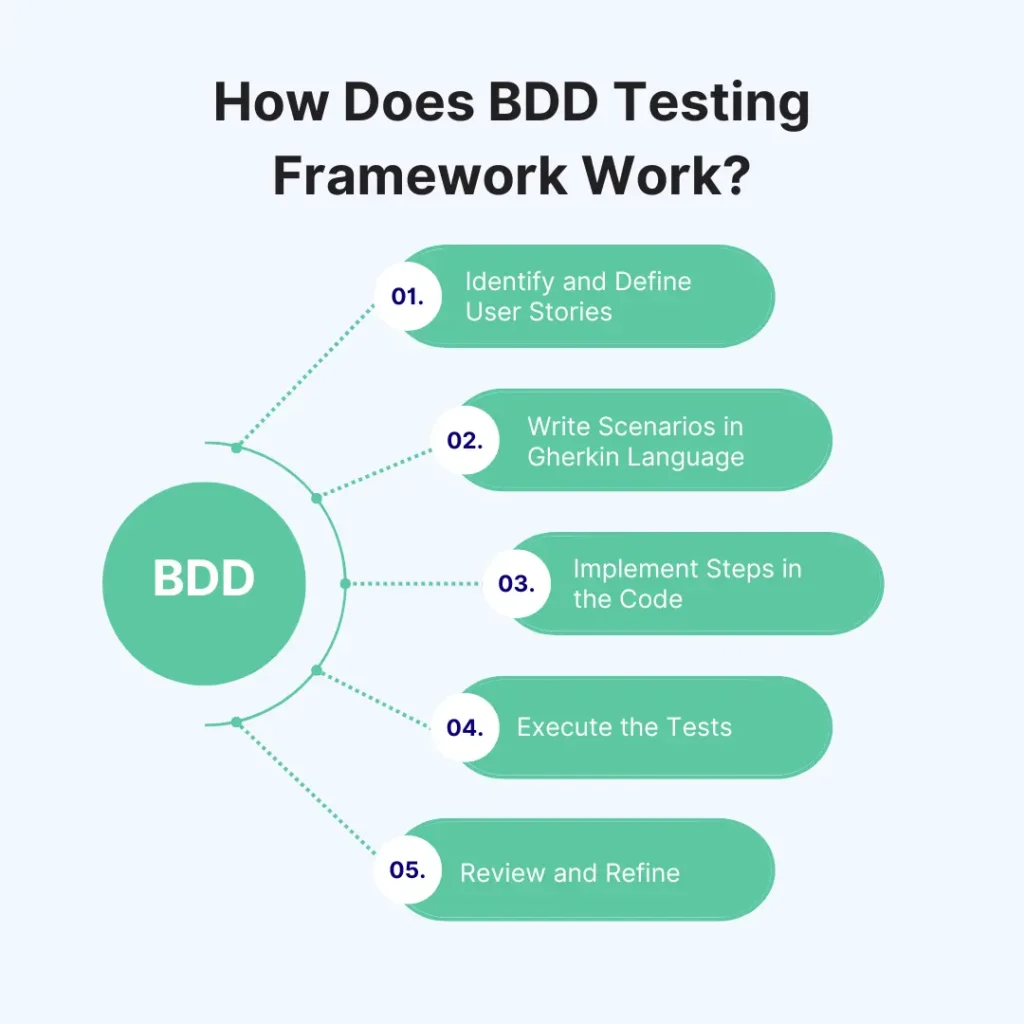
A BDD testing framework focuses on how the software should behave from the user’s perspective. The step-by-step process of implementing BDD testing is as follows:
1. Identify and Define User Stories
Start by working with stakeholders (business, developers, and testers) to create clear and simple user stories. These are short descriptions of what a user wants to achieve with the software. For example: “As a user, I want to log in to my account.”
2. Write Scenarios in Gherkin Language
Convert the user stories into BDD scenarios using the Gherkin language. Gherkin is a plain English format that describes how the software should behave. It is meant to be an easy-to-understand, non-technical way to explain how software is used.
Given (the starting condition),
When (the action taken by the user),
Then (the expected outcome).
Example:
- Given I am on the login page,
- When I enter my username and password,
- Then I should be logged in.
3. Implement Steps in the Code
After writing the scenarios, developers write the underlying code that connects each scenario step to the application. This is done using a BDD framework, such as Cucumber, which translates the plain-language steps into code that runs the tests.
4. Execute the Tests:
Run the BDD tests to check if the application behaves as expected according to the scenarios. If it passes all steps, the software is working as intended. If not, the team can identify and fix any issues.
5. Review and Refine:
Continuously review the test scenarios and results with the team. Update the scenarios if needed based on feedback or changing requirements. This helps keep the tests relevant and ensures the software continues to meet business needs.
This process ensures that all team members are aligned and the software is built according to real user needs, with clear and understandable tests.
What is BDD in Agile?
Behavior-Driven Development (BDD) is an Agile approach to software development that focuses on defining how users will interact with the application and the expected behavior. Agile BDD testing helps improve interaction and teamwork among all stakeholders, ensuring the software meets user expectations.
Here’s how it fits in:
- Clarifies Requirements: BDD testing uses simple, human-readable language to define how the software should behave. These descriptions, often written in the form of ‘user stories’ or ‘scenarios’, help teams clearly understand what is expected, reducing misunderstandings about requirements.
- Focuses on Behavior: Rather than focusing on how the code is written, the BDD testing framework centers around the expected behavior of the system. This makes it easier for teams to develop software that meets user needs.
- Early Testing: In Agile, testing is integrated early in the development process. BDD supports this by allowing tests to be written before coding begins, ensuring that features are tested as soon as they are developed.
- Improves Collaboration: BDD promotes teamwork by creating a shared language that technical and non-technical team members can understand, promoting better discussions about the features and behavior of the software.
- Supports Continuous Delivery: By automating the testing of user stories, the BDD test framework helps ensure that the software is always ready for delivery. This supports Agile’s goal of continuous delivery of working software.
In short, the BDD testing framework strengthens Agile practices by improving communication, aligning development with user needs, and enabling ongoing testing and delivery.
Example of BDD Testing
In this section, we’ll walk through a detailed example of BDD testing using a simple user story, such as a login feature. Here’s how it works:
User Story:
“As a user, I want to log in to the application so that I can access my personal dashboard.”
BDD Scenario:
In BDD testing, we describe this user story in a structured format, typically using Gherkin language. The format is:
• Given: Describes the initial context
• When: Defines the action or event
• Then: Describes the expected outcome
Example Scenario for the Login Feature:
gherkin
Copy code
Scenario: Successful login with valid credentials
Given the user is on the login page
When the user enters valid credentials
And clicks on the login button
Then the user is redirected to their dashboard
Explanation:
• Given: The test begins with the user on the login page.
• When: The user enters their correct username and password and clicks ‘Login’.
• Then: The user should be taken to their personal dashboard if the credentials are correct.
Automated Testing:
This scenario can be automated using tools such as Cucumber, where the test checks if the application behaves as expected. For example, it verifies that when valid credentials are entered, the user is successfully logged in and redirected.
This approach ensures the login feature works according to user expectations, and the BDD testing framework makes the process clearer and collaborative between technical and non-technical team members.
BDD Testing Frameworks
Here is a list of popular BDD framework tools and their key features:
Selenium
Selenium is an open-source tool that allows web browser automation. Selenium is primarily a browser automation tool, but it can be integrated with BDD frameworks such as Cucumber to support the implementation of BDD principles.
Advantages:
• Runs tests across multiple browsers (Chrome, Firefox, Safari) for consistent user experience across platforms.
• Supports various programming languages (Java, Python, C#, Ruby), making it adaptable for diverse teams.
Unique Capability:
• Executes tests on different operating systems (Windows, macOS, Linux), ideal for cross-platform testing.
Cucumber
Cucumber is one of the most popular BDD framework tools, designed to create test cases that verify how software behaves. It allows tests to be written in plain English using the Gherkin language, making them effortless to understand. Cucumber supports multiple programming languages, including Java, Ruby, and JavaScript, and helps testers ensure that the software functions as expected.
• Advantages:
- Easy to read and understand for non-technical stakeholders.
- Extensive language and platform support.
• Unique Capability: Strong integration with other testing tools and frameworks, such as Selenium for UI testing.
SpecFlow
SpecFlow is an open-source BDD testing framework for .NET environments that smoothly integrates to run human-readable acceptance tests in .NET projects. Tests in SpecFlow are written using Gherkin, the official Gherkin parser, which allows you to create test cases in plain language. It supports over 70 natural languages, making it uncomplicated for developers and non-technical stakeholders to understand.
• Advantages:
- Native support for .NET and integration with popular .NET tools.
- Easy setup for developers familiar with Microsoft ecosystems.
• Unique Capability: Seamless integration with Azure DevOps for continuous integration (CI) and continuous delivery (CD).
JBehave
A Java-based BDD framework, JBehave was created before Cucumber and is still widely used for Java projects. It also uses Gherkin-like syntax for writing stories and scenarios. The JBehave framework shifts away from traditional testing terms and instead focuses on a vocabulary centered around verifying software behaviors.
• Advantages:
-
- Built specifically for Java, making it ideal for Java-based projects.
- Good documentation and support for integration with Java development tools.
• Unique Capability: Customizable story execution patterns for advanced scenarios.
Behat
Behat is an open-source BDD test framework for PHP projects. It’s a tool that helps you deliver important software by ensuring ongoing communication, focused discovery, and automated testing. Like Cucumber, it uses Gherkin to write user scenarios in a readable format and is ideal for web application testing.
• Advantages:
- Tailored for PHP developers, offering integration with Symfony and other PHP frameworks.
- Strong community support and well-documented for PHP ecosystems.
• Unique Capability: Built-in support for Mink, allowing it to simulate browser interactions for functional testing.
Comparison of Features:
| Framework | Best For | Language Support | Unique Strength |
| Selenium | Web application testing | Java, Python, C#, Ruby | Cross-browser, cross-platform automation for web applications |
| Cucumber | Multi-language support | Java, Ruby, JavaScript | Broad ecosystem and tool integration |
| SpecFlow | .NET applications | C# | Native integration with Visual Studio and .NET |
| JBehave | Java applications | Java | Advanced story execution customization |
| Behat | PHP web applications | PHP | Strong support for browser simulation via Mink |
Each of these BDD testing frameworks excels in different environments, so the choice depends on your development stack and specific project requirements.
Advantages of BDD Testing Frameworks
1. Improved Communication:
BDD testing tools encourage regular discussions between team members, including developers, testers, and business stakeholders. By using a common language such as Gherkin, everyone can easily understand and contribute to the test scenarios, leading to better teamwork and fewer misunderstandings.
2. Better Understanding of Requirements:
BDD testing framework helps ensure that requirements are clear and well-understood from both technical and non-technical perspectives. By defining test scenarios in plain language, all team members, including those without technical backgrounds, can grasp what the software needs to do.
3. Early Detection of Issues:
By writing tests before coding (a practice known as ‘test-first’ or ‘test-driven development’), BDD testing helps identify issues early in the development process. This early detection means bugs can be fixed before they become more complex and costly to address.
4. Enhanced Test Coverage and Software Quality:
BDD tests cover various scenarios and edge cases, improving overall test coverage. This thorough testing helps ensure that the software meets user expectations and behaves correctly in different situations, leading to higher software quality.
5. Automated Testing
BDD scenarios can be automated with tools such as Cucumber or SpecFlow. This allows for quick and reliable feedback on the application’s behavior, helping teams identify regressions early and maintain consistent quality.
6. Better Code Quality
BDD promotes better code quality by defining clear, user-focused requirements. This approach reduces errors, improves code structure, and makes it easier to maintain. Continuous testing helps detect problems early, resulting in more reliable software.
Limitations of BDD Testing Frameworks
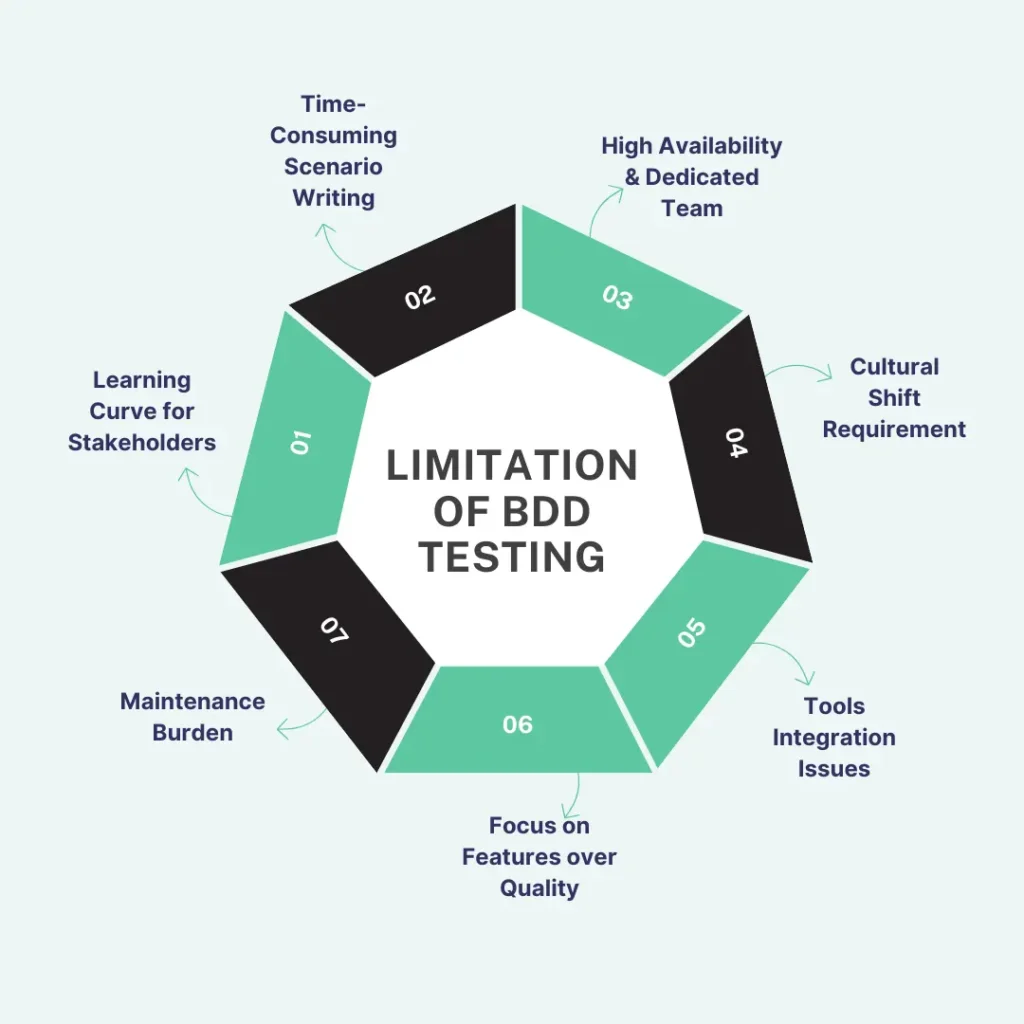
While BDD testing tools can boost collaboration and better align development with business goals, it also comes with challenges that the teams need to address to fully benefit from it.
1. Learning Curve for Stakeholders:
• Stakeholders who are new to BDD testing frameworks may face a learning curve. Understanding and effectively using BDD practices, including writing scenarios in Gherkin, can take time and training.
2. Time-Consuming Scenario Writing:
• Creating detailed and comprehensive test scenarios can be time-consuming. Ensuring that scenarios are well-defined and cover various aspects of the software may require significant effort and ongoing maintenance.
3. High Availability and Dedicated Team:
• BDD testing often requires a dedicated team of developers to work closely with clients. The need for quick response times and constant availability can be demanding and may require significant resource allocation.
4. Cultural Shift Requirement:
• Adopting the BDD approach effectively may require a cultural shift within the team. Teams need to embrace a collaborative approach and a shared understanding of requirements, which can be challenging if team members are used to traditional testing or poor communication.
5. Tools Integration Issues:
• BDD tools might not always work well with the current development setup or may have limited features, which can make the process more difficult.
6. Focus on Features over Quality:
• Teams might spend too much time on writing feature scenarios, and overlook the overall quality of the application, leading to possible gaps in testing.
7. Maintenance Burden:
• As the application changes, BDD scenarios might need frequent updates. If scenarios are not well-organized or too closely tied to specific implementations, maintaining them can become a burden.
What are the Differences between BDD and TDD?
This table outlines the primary differences and focus areas between BDD and TDD in Agile methodologies.
| Aspect | BDD (Behavior-Driven Development) | TDD (Test-Driven Development) |
| Focus | User behavior and application functionality. | Code implementation and unit functionality. |
| Test Description | Written in plain language (e.g., Gherkin) to describe user stories and expected behavior. | Written in code to test small units of functionality. |
| Collaboration | Emphasizes collaboration between developers, testers, and non-technical stakeholders. | Primarily involves developers and focuses on unit testing. |
| Scope | Tests are typically written to cover broader scenarios and user interactions. | Tests are usually focused on individual functions or methods. |
| Language Used | Plain English or domain-specific language (e.g., Gherkin). | Programming language code. |
| Purpose | To ensure that the software meets user expectations and behaviors. | To verify that the code works correctly and meets design specifications. |
| Test Driven | Tests are written before the code to describe desired behavior. | Tests are written before the code to ensure functionality. |
| Outcome | High-level features and user stories are validated. | Low-level code correctness is validated. |
| Tool Integration | Tools such as Cucumber, SpecFlow, and Behat are used. | Tools such as JUnit, NUnit, and pytest are used. |
| Feedback Cycle | Provides feedback on whether the software meets user needs and expectations. | Provides feedback on code correctness and functionality. |
Conclusion
BDD testing is a powerful approach that enhances collaboration and alignment between development and business goals. By focusing on user behaviors and creating clear, human-readable test scenarios, BDD testing frameworks help ensure that software meets user expectations and functions correctly. However, the BDD process does come with its own set of challenges, including the learning curve for stakeholders, time-consuming scenario creation, and potential integration issues.
To navigate these challenges and improve your testing processes, consider leveraging QA Touch. With its special features such as simplified test management, Jira integration, and innovative ChatGPT-powered test case writing, QA Touch is designed to address common pain points in test management. It offers a centralized platform to maintain test assets, track execution, and ensure comprehensive coverage, all while enhancing collaboration among team members.
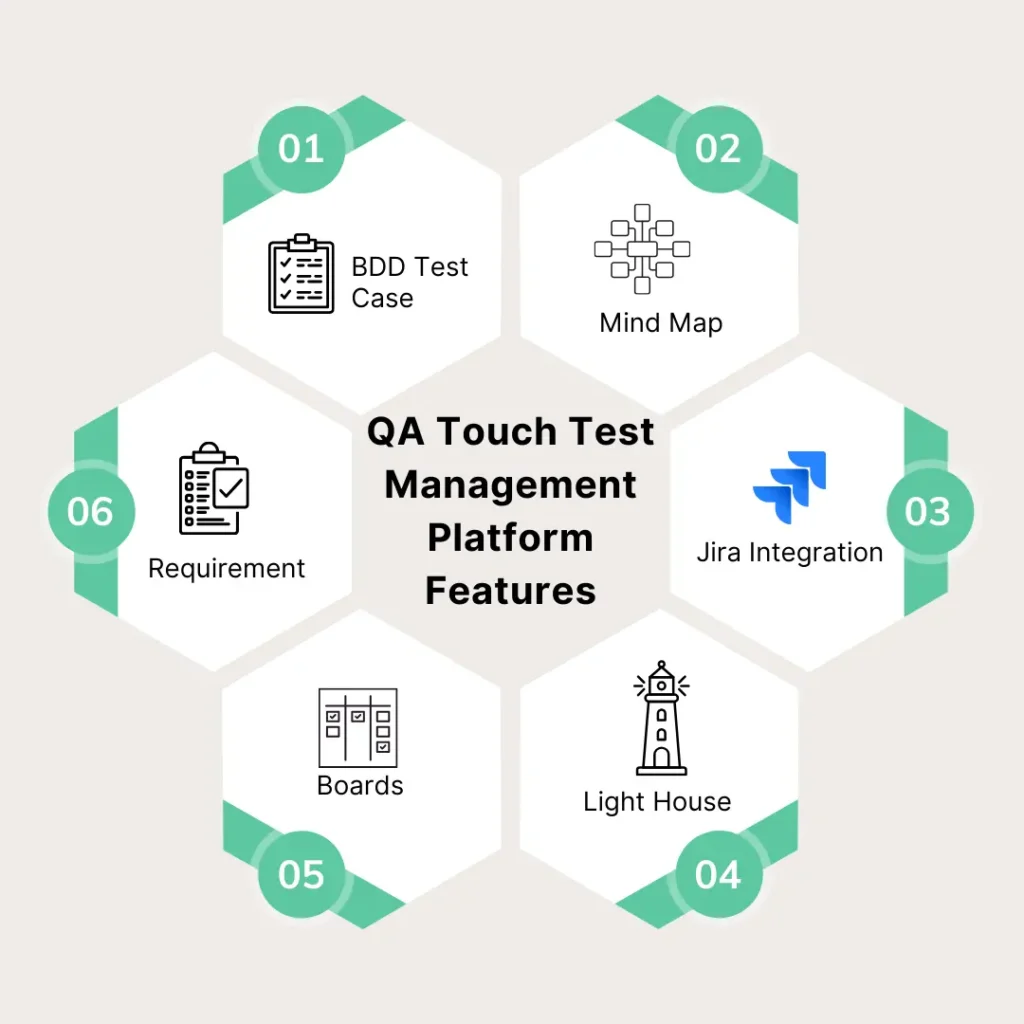
Ready to take your testing to the next level? Try QA Touch today and experience the difference. Get started with QA Touch and see how our advanced features can streamline your test management process and boost your team’s productivity. Connect with us for a personalized demo or to discuss how QA Touch can meet your specific needs.




